
React, also called ReactJS or React.js, aims to be speedy, simple, and scalable. According to wikipedia, React is a JavaScript library for building user interfaces. From what I have read in the contents of the strings I have translated so far, is that it is maintained by the same engineers behind the Facebook and Instagram and a lot of other big companies (like Twitter) are using them. Their translation project in Crowdin is huge and I have previously submitted contributions of strings that I have translated for them. I am on the 9th folder for the this translation project for Facebook-React. This folder has over 3000 words and I have translated 35% of it for this contribution. Below are the screenshots of my work in progress.
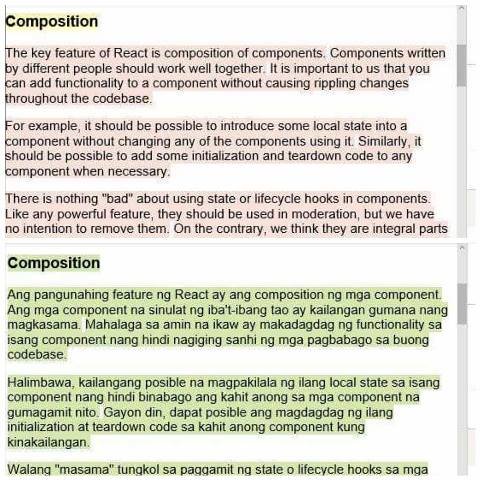
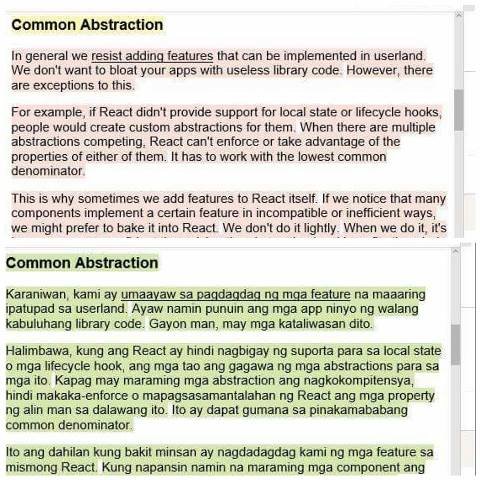
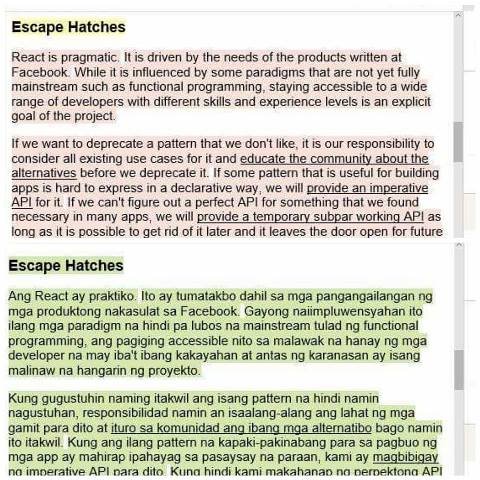
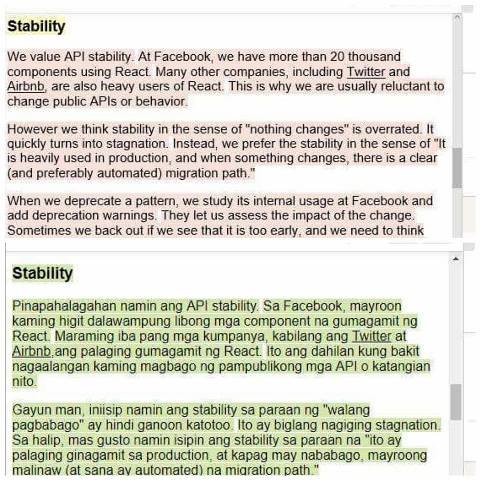
Below are samples of the translated strings:
We wrote this document so that you have a better idea of how we decide what React does and what React doesn't do, and what our development philosophy is like.
Sinulat namin ang dokumentong ito upang kayo ay magkaroon ng mas maiging pang-unawa kung paano namin napagdedesisyunan ang mga ginagawa at hindi ginagawa ng React, at kung ano ang pilosopiya namin ukol sa development nito.
This document assumes a strong understanding of React. It describes the design principles of React itself, not React components or applications.
Pinagpapalagay ng dokumentong ito ang iyong matibay na pag-unawa sa React. Inilalarawan nito ang mga design principle ng mismong React, hindi ang mga component ng React o mga application.
It is important to us that you can add functionality to a component without causing rippling changes throughout the codebase.
Mahalaga sa amin na ikaw ay makadagdag ng functionality sa isang component nang hindi nagiging sanhi ng mga pagbabago sa buong codebase.
For example, it should be possible to introduce some local state into a component without changing any of the components using it.
Halimbawa, kailangang posible na magpakilala ng ilang local state sa isang component nang hindi binabago ang kahit anong sa mga component na gumagamit nito.
We might enable more functional patterns in the future, but both local state and lifecycle hooks will be a part of that model.
Marahil ay i-enable namin ang more functional patterns sa hinaharap, pero ang local state at mga lifecycle hook ay parehong magiging bahagi ng model na iyon.
Components are often described as "just functions" but in our view they need to be more than that to be useful.
Madalas inilalarawan ang mga component bilang "mga function lang" pero sa tingin namin ay kailangan nilang maging higit pa rito upang maging kapaki-pakinabang.
Some external libraries like Relay augment components with other responsibilities such as describing data dependencies.
Ang ilan sa mga external na mga library tulad ng Relay ay dinadagdag ang mga component sa ibang mga resposibilidad gaya ng pagsasalarawan ng mga data dependency.
For example, if React didn't provide support for local state or lifecycle hooks, people would create custom abstractions for them.
Halimbawa, kung ang React ay hindi nagbigay ng suporta para sa local state o mga lifecycle hook, ang mga tao ang gagawa ng mga abstractions para sa mga ito.
When there are multiple abstractions competing, React can't enforce or take advantage of the properties of either of them.
Kapag may maraming mga abstraction ang nagkokompitensya, hindi makaka-enforce o mapagsasamantalahan ng React ang mga property ng alin man sa dalawang ito.
If we notice that many components implement a certain feature in incompatible or inefficient ways, we might prefer to bake it into React.
Kung napansin namin na maraming mga component ang nagpapatupad ng ilang mga feature na hindi angkop o di kaya'y hindi mabisang pamamaraan, maaring mas gugustuhin namin na isama ito sa React.
While it is influenced by some paradigms that are not yet fully mainstream such as functional programming, staying accessible to a wide range of developers with different skills and experience levels is an explicit goal of the project.
Gayong naiimpluwensyahan ito ilang mga paradigm na hindi pa lubos na mainstream tulad ng functional programming, ang pagiging accessible nito sa malawak na hanay ng mga developer na may iba't ibang kakayahan at antas ng karanasan ay isang malinaw na hangarin ng proyekto.
If we want to deprecate a pattern that we don't like, it is our responsibility to consider all existing use cases for it and educate the community about the alternatives before we deprecate it.
Kung gugustuhin naming itakwil ang isang pattern na hindi namin nagustuhan, responsibilidad namin an isaalang-alang ang lahat ng mga gamit para dito at ituro sa komunidad ang ibang mga alternatibo bago namin ito itakwil.
This is a screenshot of my recent activities in my Crowdin account as dandalion, same username as my Utopian and Steemit accounts. You can also check it using this link

Click here to go to the Crowdin Project, to see this:
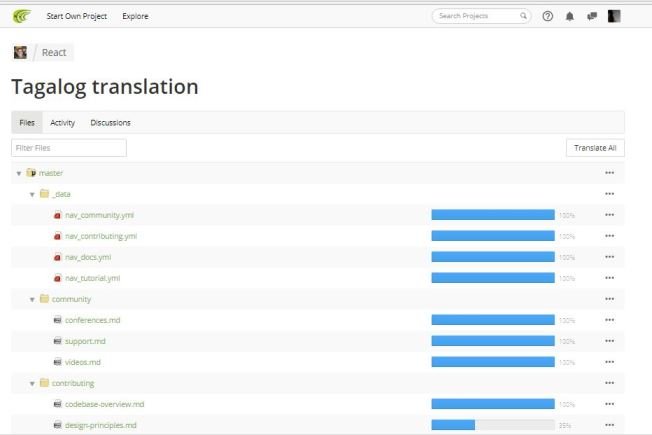
Posted on Utopian.io - Rewarding Open Source Contributors
